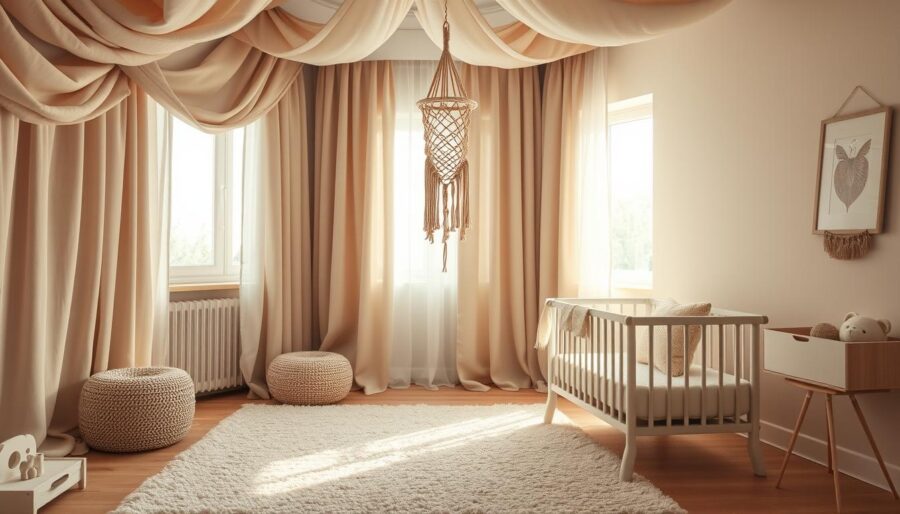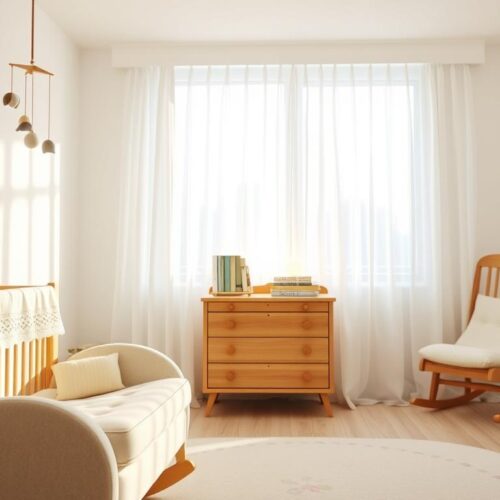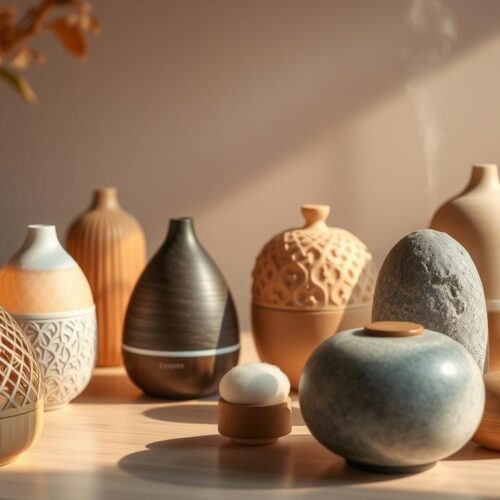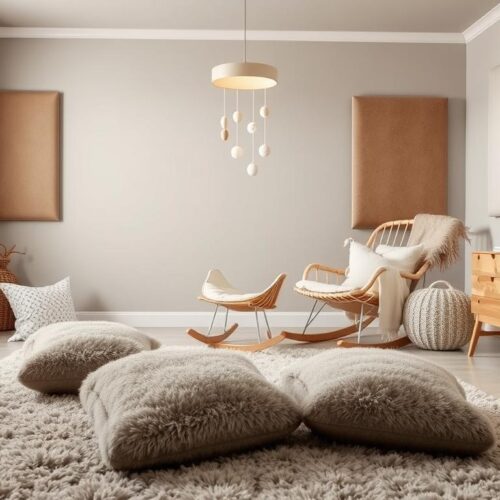When setting up a baby’s room, it’s key to think about soundproofing. Sounds may bother infants’ sensitive ears, affecting their sleep and comfort. Using sound-absorbing fabrics helps create a calm space. It’s like the quiet sounds babies hear in the womb.
These fabrics don’t just block noise; they also improve the room’s acoustics. By adding them, you can make the nursery a peaceful haven for your baby.
Introduction to Sound Absorption in Nurseries
Nurseries need special sound treatment because babies are sensitive to noise. Using sound absorption textiles helps make a calm place. This helps babies sleep well and reduces stress.
Sound absorption textiles make the nursery sound better. They catch and soften noise, which balances the sound in the room.
It’s important for parents to know about acoustic insulation fabric. These materials are both useful and nice-looking. They keep the nursery quiet without sacrificing style.
Why Soundproofing is Important for Nurseries
Soundproofing nurseries is key to keeping infants comfortable. Babies often switch between light and deep sleep. They can wake up easily from loud sounds. Using special noise-reducing textiles helps lessen these disturbances. This makes sleep more peaceful and steady for them.
Less noise thanks to soundproofing fabrics also helps everyone feel better. It lowers stress for babies and parents alike. This peace of mind improves the nursery’s atmosphere. It supports good sleep habits. These are essential for a baby’s growth and development.
Types of Sound Absorbing Fabrics
When picking fabrics to absorb sound in nurseries, there are many great options. Thick curtains, acoustic panels, and dense rugs are popular. These choices help soak up sound and cut down on echo, making the room quieter.
Thick curtains, like those made of velvet or heavy cotton, are great for noise reduction. They make the nursery calm. Acoustic panels, from foam or mineral wool, are easy to put up and improve sound quality a lot.
Dense rugs, especially wool ones, absorb sound on the floor. They make the room quieter and are cozy for babies to play on. Using different sound absorbing fabrics together can balance the nursery’s acoustics well.
Acoustic Fabric Panels for Nurseries
Acoustic fabric panels play a key role in making nurseries quiet. They lower echo and make sounds clearer. Panels come in materials like foam or mineral wool and look good too. You can put them on walls or ceilings to soak up sound and better the room’s acoustics.
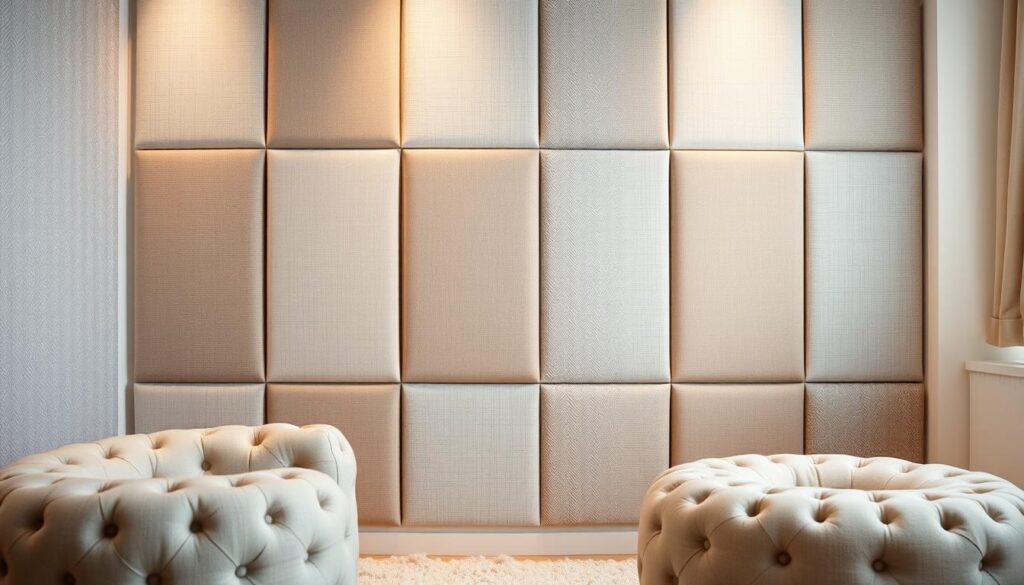
These panels greatly cut down noise, making a calm space for your baby. Made with stuff like high-density foam, they’re great at soaking up sound. This is super important in nurseries to help babies sleep well and stay comfy.
They’re not just useful; they also make the nursery look better. You can pick from many colors and fabrics to match the nursery’s look. These panels are easy to set up, which is handy for parents wanting to better sound quality in the nursery.
In short, getting acoustic fabric panels is a wise move for any nursery. They improve sound and cut down noise, making a soothing place for your baby. For parents seeking both function and style, these panels are the perfect choice.
Soundproofing with Curtains
Soundproofing curtains are great for nurseries. Made from soundproof fabric, they do two things. They keep out unwanted noise and keep the room warm. These curtains use thick, tightly woven materials. This helps to lessen noise from outside, like traffic or loud neighbors.
By using these curtains, you create a calm space for your baby. They lower the noise coming in. This lets your baby sleep without being disturbed. The thick fabric also keeps the room at a steady temperature. This makes your child feel more comfortable and safe.
Using Rugs and Carpeting for Sound Dampening
Rugs and carpeting are key for reducing noise in a nursery. They not only make the room cozier but also block sound, especially on hard floors. Carpets with thick piles are great at soaking up noise and cutting down echo. This improves the nursery’s sound quality.
When picking rugs for a nursery, think about the materials and textures. Go for thicker, denser carpets to soak up more sound. This helps lower noise and makes the room quieter. High-pile rugs, in particular, are good for better sound quality. They ensure the nursery is calm and quiet.
These textiles also make the space look better and feel warmer. Place rugs in areas where people walk a lot or under furniture. This reduces noise and also keeps your floors safe. Such textiles are vital for a nursery’s design, making it practical and cozy.
Sound-Absorbing Wall Panels
Sound-absorbing wall panels help keep nurseries quiet by reducing noise. They use materials like fiberglass, foam, or acoustic fabrics. These materials cut down on sounds from next door or outside. They also look good, matching the nursery’s style.
Adding sound-absorbing fabrics makes these panels even better. They’re easy to put up and look great. Here’s a look at the best materials for sound-absorbing wall panels:
| Material | Characteristics | Noise Reduction Capability |
|---|---|---|
| Fiberglass | Lightweight, good insulation properties | High |
| Foam | Easy to cut and install, affordable | Moderate |
| Acoustic Fabrics | Customizable designs, blends with décor | High |
Soundproof fabric for walls lowers noise and decorates your nursery. Choosing the right sound-absorbing fabrics helps make a peaceful place for your baby to sleep and play.
How to Arrange Furniture for Noise Reduction
Arranging furniture the right way can change how sound moves in a nursery. Put heavy items like bookshelves or dressers against walls that are next to noisy rooms. They work as an extra sound barrier. Using noise reduction textiles and sound deadening fabric becomes more effective this way. For example, a bookshelf filled with books isn’t just for storage. It also helps block sound.
Move the crib away from places where noise comes in, like windows by busy streets. Doing this helps keep the baby’s sleep area quiet. It makes sure the outside noise doesn’t disturb their sleep. It also makes sound deadening fabric in the room work better.
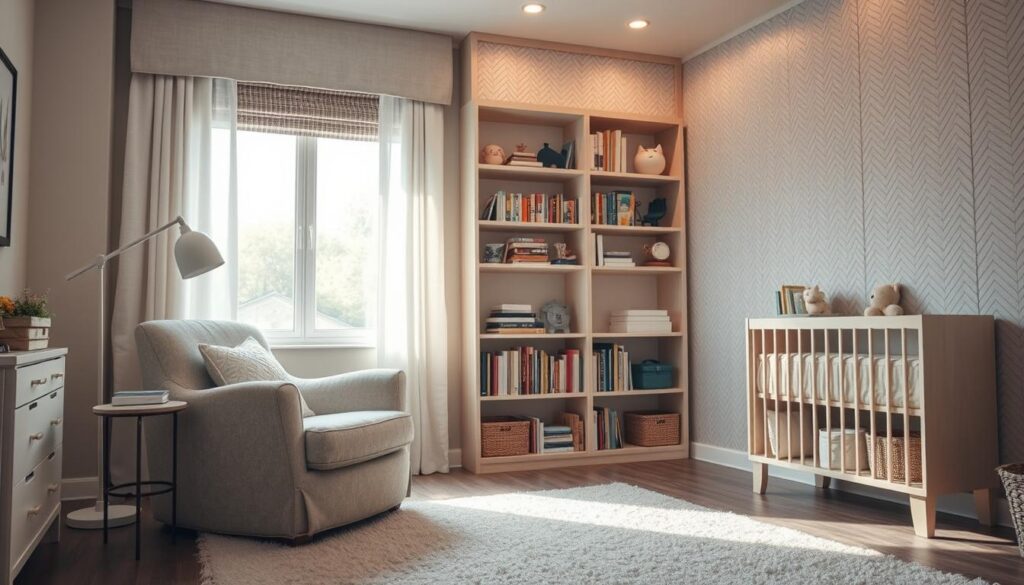
| Furniture | Placement Tips | Benefits |
|---|---|---|
| Bookshelves | Against shared walls | Additional sound barrier |
| Crib | Away from windows | Minimized noise disturbance |
| Dressers | Near noise-prone areas | Noise absorption |
Choosing the Right Sound-Absorbing Fabrics
Finding the best sound absorbing material for a nursery means looking at a few key things. The weight and texture of the fabric are very important. Heavy fabrics with tight weaves are better at stopping sound. Velvet and wool are great because they block noise well.
There’s also special acoustic insulation fabric made just for controlling sound. These fabrics are made to keep noise out and help make the nursery a calm, quiet place. It’s ideal for helping babies sleep well.
Solserene Fabric System
The Solserene fabric system is a perfect way to soundproof nurseries. It uses a high-density fiberboard, fiberglass mesh, and acoustically transparent fabric. This combo effectively reduces noise. It makes your nursery quieter, helping your baby sleep better and grow in a calm space.
Installing the Solserene fabric system is easy and quick. This means less hassle for you. When you add this system to your nursery, it keeps noise out. It helps your baby sleep well. Plus, it makes the room look nice, mixing beauty with function.
The Solserene fabric system works well because it layers soundproofing materials. There’s a tough fiberboard at the base and a durable fiberglass mesh on top. The outer fabric absorbs sound well. These layers make your nursery peaceful. You’ll know your baby can enjoy a quiet place to rest.
How to Install Acoustic Fabrics in a Nursery
Making your nursery quieter with sound-absorbing fabrics is smart and makes it look better. Follow these steps for a smooth installation of sound-proofing materials:
- Selecting the Fabric: Choose sound-absorbing fabrics that look good in the nursery. Options like felt, polyester blends, and thick cotton work well.
- Gathering Tools: Collect simple tools like a measuring tape, scissors, a staple gun, adhesive spray, brackets, and screws. Having everything ready prevents delays.
- Preparing the Surface: Make sure the walls are clean before starting. Dust and dirt can stop the adhesive from working well.
- Measuring and Cutting: Measure the space for the fabric. Then cut the sound-absorbing material, leaving extra room for any needed changes.
- Installing Panels: Use brackets and screws for pre-made panels. For fabrics, spray adhesive on custom frames then secure them to the wall.
- Final Adjustments: Get rid of any wrinkles or bubbles for a neat finish.
By choosing carefully and using the right methods, you can make your nursery quieter and more stylish.
Soundproofing the Floor
Soundproofing the floor in a nursery is key to making a calm space for your baby. One smart way to do this is by using sound absorption textiles. These materials are great at reducing noise, keeping sounds from the floor below away.
Putting in a soundproof underlayment is a common way to lessen vibrations from the floor. These underlayments soak up the noise made by moving or dropping things. They help keep the nursery quiet by stopping sound from coming through.
Another top choice is to lay down thick carpeting with an acoustic fabric panel underneath. Both make the nursery cozier and much quieter for your baby. Acoustic fabric panels also make the room look better while they cut down on noise.
Here are some great soundproofing options:
- Soundproof underlayments
- Dense carpeting with sound absorption textiles
- Acoustic fabric panels
To keep your nursery peaceful, think about these soundproofing ideas. Using sound absorption textiles and acoustic fabric panels really helps control noise. This makes sure your baby has a quiet place to rest.
Impact of Windows on Nursery Noise Levels
Windows are key in controlling nursery noise. Single-pane windows let in a lot of noise, disturbing baby sleep. Switching to double-pane windows can vastly improve sound insulation.
Adding soundproof materials to walls also helps. These materials absorb and block noise. This is great for nurseries in loud areas.
You could also use thick curtains or special window inserts. These cut down on outside noise. Thus, they make the nursery calmer for your baby.
Here’s how different window treatments stack up in noise control:
| Window Treatment | Noise Reduction Level | Additional Benefits |
|---|---|---|
| Single-Pane Window | Low | None |
| Double-Pane Window | Moderate | Improved Insulation |
| Heavy Drapes | Moderate to High | Light Blocking |
| Soundproof Window Inserts | High | Energy Efficiency |
In short, using double-pane windows and soundproofing materials can make a nursery much quieter. It helps your baby sleep better.
Sound Absorbing Drape
Sound absorbing drapes are great for making nurseries quieter. They are made of thick fabrics that block out noise well. By putting them over windows or using them as dividers, you make a peaceful spot for your baby.
Velvet is a top pick because it’s lush and blocks sound well. Microsuede is another choice. It’s soft, easy to care for, and also good at stopping noise. These materials soak up sound, making the room less echoey and noisy.
Putting up these drapes is easy. But you need strong curtain rods because the drapes are heavy. Make sure they go from the ceiling to the floor and cover the windows completely. This cuts down on noise and makes the room look good. These drapes are a smart buy, adding both style and quiet to a nursery.

